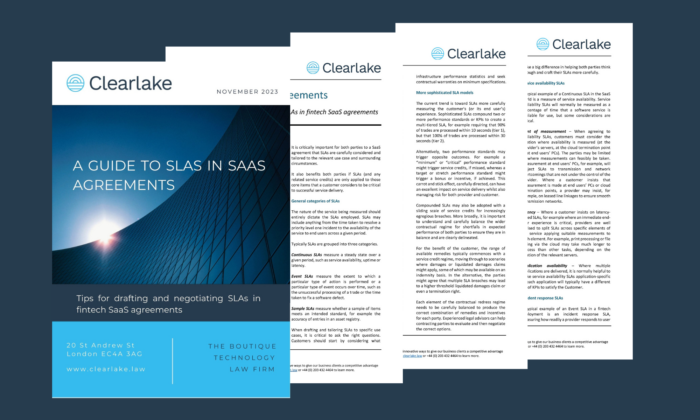Service level agreements (SLAs) and related service credits have traditionally combined as the first line of remedies for customers in software-as-a-service (SaaS) agreements.
The purpose of SLAs is to document the level of performance expected by a customer and (if well drafted) to provide an objective way of monitoring that performance through the term of an agreement.
It is critically important for all parties to a SaaS agreement that SLAs are carefully considered and are tailored to the relevant use case and surrounding circumstances.
It is also to the benefit of both parties that SLAs (and any related service credits) are only applied to those core items that a customer considers to be critical to successful service delivery.
This remainder of this post is a brief summary of our white paper, “SaaS Service Level Agreements: Tips for drafting and negotiating SLAs in SaaS agreements“.

General categories of SLAs
Typically, SLAs are grouped into three categories.
Continuous SLAs measure a steady state over a given period, such as service availability, uptime or latency. Service availability SLAs will normally be measured as a percentage of time that a software service is available for use, but some considerations are critical, including carefully defining the the point of measurement and ensuring the SLAs are application specific.
Event SLAs measure the extent to which a particular type of action is performed or a particular type of event occurs over time, such as the unsuccessful processing of a trade or the time taken to fix a software defect. These types of SLAs are heavily reliant on the type of activity measured. Helpdesk response SLAs, for example, will typically be varied in relation to differing priority levels of incidents.
Sample SLAs measure whether a sample of items meets the intended standard, for example the accuracy of entries in an asset registry.
Drafting SLAs
When drafting and tailoring SLAs to specific use cases, it is critical to ask the right questions, starting by considering what elements of the service are critical for the use case. For example, what elements of this SaaS service directly affect my end users? What problems might cause the customer loss?F
Once the target of the SLAs is established, a further set of questions should define the relevant building blocks of the SLA. For example, what does “Availability” actually mean? Availability to whom? How is it measured? Where is it measured?
Frequently, there are also regulatory considerations to drafting SLAs, for example, in the United Kingdom, under the Financial Conduct Authority’s “FG16/5 Guidance for firms outsourcing to the cloud” which applies to the supply and procurement of various fintech applications.
More sophisticated SLA models
The current trend is toward SLAs more carefully measuring the customer’s (or its end user’s) experience.
Sophisticated SLAs compound two or more performance standards or KPIs to create a multi-tiered SLA, for example requiring that 90% of trades are processed within 10 seconds (tier 1), but that 100% of trades are processed within 30 seconds (tier 2).
Alternatively, two performance standards may trigger opposite outcomes. For example a “minimum” or “critical” performance standard might trigger service credits, if missed, whereas a target or stretch performance standard might trigger a bonus or incentive, if achieved.
A carrot and stick effect, carefully directed, can have an excellent impact on service delivery whilst also managing risk for both provider and customer.
This post is an extract from Dan Stanton’s comprehensive white paper, “SaaS Service Level Agreements: Tips for drafting and negotiating SLAs in SaaS agreements“.

About Clearlake
Clearlake Law provides fractional general counsel services to organisations across multiple technology sectors doing business in the United Kingdom.
Please feel free to reach out directly to the author of this post, Dan Stanton, on dan.stanton@clearlake.law or 0204 570 8741.




